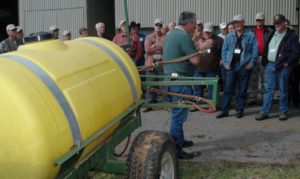Weeds in warm-season pastures can be an annual battle, and producers should prepare their spray equipment to win the war, said a Texas A&M AgriLife Extension Service expert.

Sprayer calibration is an important part of pasture management. Producers should check their equipment and test it to make sure herbicide and insecticide applications are effective. (Texas A&M AgriLife Extension Communications photo)
Now is a good time to calibrate equipment and reflect on the previous year’s weed and pest insect issues to apply successful treatments to warm-season pastures, said Dr. Vanessa Corriher-Olson, AgriLife Extension forage specialist, Overton.
“Take the time to calibrate sprayer equipment to make sure it is working properly,” she said. “As it sits over winter the rig may be displaced or dirt dobbers or other bugs might have gummed the nozzles up. The main thing to make sure it’s putting out the correct amount of herbicide or insecticide intended.”
Too much or too little product application on a hayfield can cost producers, Corriher-Olson said. Spraying too much increases the cost of an application and could be against the label recommendation, which is the law. Too little application could be ineffective and require additional treatments.
“Proper calibration could mean huge savings because those applications represent money,” she
said. “It’s worth the time to check.”
When calibrating, Corriher-Olson said equipment should be run as if spraying a field under normal conditions.
“Don’t go faster or slower than you would go in the field,” she said. “Fields may have hog damage or ant mounds or other terrain features that can affect speed and changes of speed will affect the volumes being applied to the field.”
Corriher-Olson said how many gallons of water the sprayer puts out per acre and following individual products’ mixing rates are a big part of ensuring fields receive the right amount of product. She also suggests producers who use multiple products to test mix them in mason jars to check for coagulation and avoid damage to equipment.
“Follow the directions,” she said. “There is a lot of information on the product label because most have different instructions based on chemistry.”
Corriher-Olson said her site https://foragefax.tamu.edu/ has several publications that focus on weed control and management of pastures and forages, including links to assist with weed identification.
Weeds will begin to emerge as temperatures begin to rise, she said. Producers should be scouting improved pastures and be prepared to spray at the appropriate time to deal with common weeds.
Identifying weeds correctly and understanding when and what to apply is paramount when treating pastures meant for hay production or grazing, she said.
“ID weeds as soon as possible to make the best herbicide selection and time to spray,” she said.
For instance, annual weeds such as goatweed, or wooly croton, should be sprayed when they are small and growing, she said. Perennial weeds such as wild blackberries should be sprayed at bloom or after seed drop.
Corriher-Olson said landowners with questions or concerns should contact their county’s AgriLife Extension office for application recommendations based on local conditions.
“There are a lot of good general-use, broadleaf products available,” she said. “The most important thing is to use products labeled for pastures and forages and to apply them effectively.”
Source: Texas A&M AgriLife Today



Leave A Comment